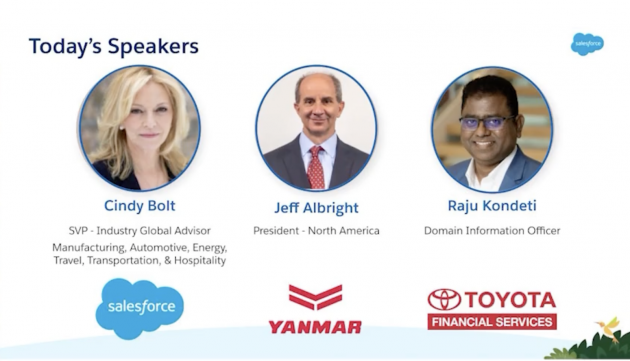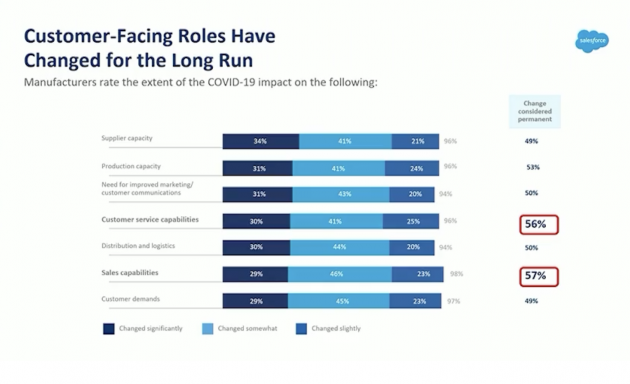
Accelerating digitization to unlock the value chain
by Alanna Fairey, Associate Editor
Manufacturing and automotive professionals discuss how the pandemic exposed weaknesses along the value chain and how they pivoted

No one could have predicted what 2020 had in store.
The destabilizing force of the pandemic exposed weaknesses along the entire value chain for manufacturing and automotive companies.
In a webinar moderated by Cindy Bolt, SVP – industry global advisor at Salesforce, Jeff Albright, President of YANMAR America, Raju Kondeti, Domain Information Office at Toyota Financial Serivces discussed the destabilizing force of the pandemic exposing weaknesses along the entire value chain for manufacturing and automotive companies. It changed how business is done and how manufacturers connect with customers.

In a survey of over 700 manufacturers around the world and across all different subverticals, it unsurprisingly revealed that the pandemic really impacted their business.
“What was interesting from this survey is that they shared some things were more long-term than others, some things were very significant to their business,” Bolt said in her opening address. “In the manufacturing space, most of them like all of us were not used to working remotely.
“And the way that was required this last few months, and then there were some things that were more slight in terms of the changes to the business.”
According to Bolt, the survey results were “enlightening”, as it shed light on conversations that manufacturers were having.
“We wanted to hear from the C-suite, and what we found with some of the questions that we asked the C-suite is these, these were the ones that were the top of mind, and not surprising over the next two years,” Bolt relates.
Albright shares that when the pandemic first hit in March 2020, YANMAR America was in “crisis management mode” planning for the first month and a half.
Returning back to the office last summer, Albright shares that they were still unable to visit customers and did most of their work remotely, which he says changed the way they approach business.
“At the same time for our businesses, the orbit business, strangely enough, it’s been an incredible voyage here about,” Albright recounts. “We had a little bit of a dip in the beginning of the spring last year, but our trackers have been sold out basis for quite some time, as has a lot of our construction equipment.
Adds Albright: “We’ve seen a lot of uplift.”
Looking ahead at the future of digitalization in manufacturing, he calls in a “blessing and curse”, explaining that “a strong market share means that you don’t get fired for doing what you did last year. But you do if you try something new, and it fails.”
“Since [YANMAR’s] market share is growing but still small, we have the opportunity to be more aggressive and trialing technologies and we feel like digital marketing is a great answer for us in being very targeted with our very select customer base, and it will been we’ve already seen it, provide a very large ROI for the money we have spent,” Albright says. “It’s creating a big upset.”
For his part, Kondeti says that the pandemic amplified the services that Toyota has always provided and were able to pivot quickly to a digital platform.
“For our customers, we realized that the economic impact is going to be hard on them, and we announced a program that actually allowed them to take advantage of free extensions on their loans, as well as three deferrals on their leases,” Kondeti says. “We were able to provide all these products and we needed to react, through digital channels to allow them to self service all these.”
Kondeti went on to explain that Toyota’s call centers are set up to receive between 100 to 200 calls related to the extension center, which he says for Toyota is not very common.
“All of a sudden, after we offered the program quickly to help our customers, we realize that there were 2000 calls flowing in every day,” Kondeti says. “We needed to react quickly and have them go through the digital channels and thanks to our partners, we were able to enable that quickly within two weeks, and Salesforce played major part in that.”